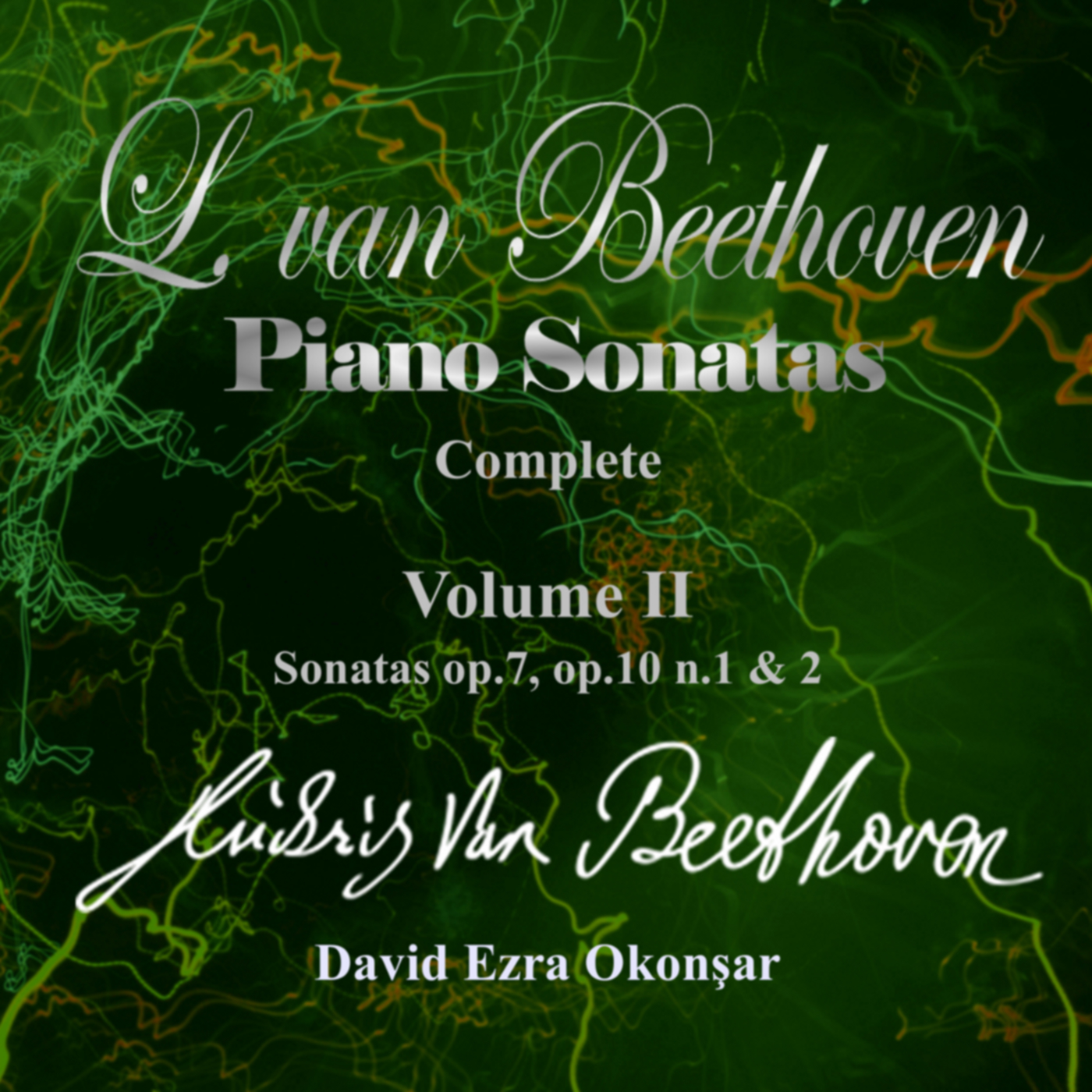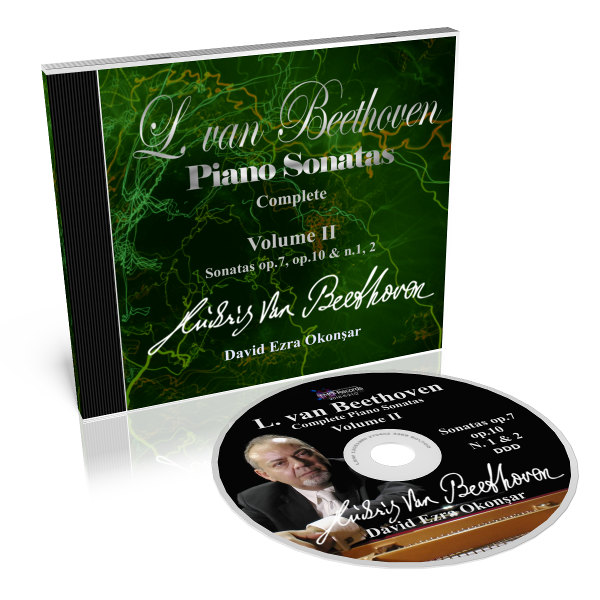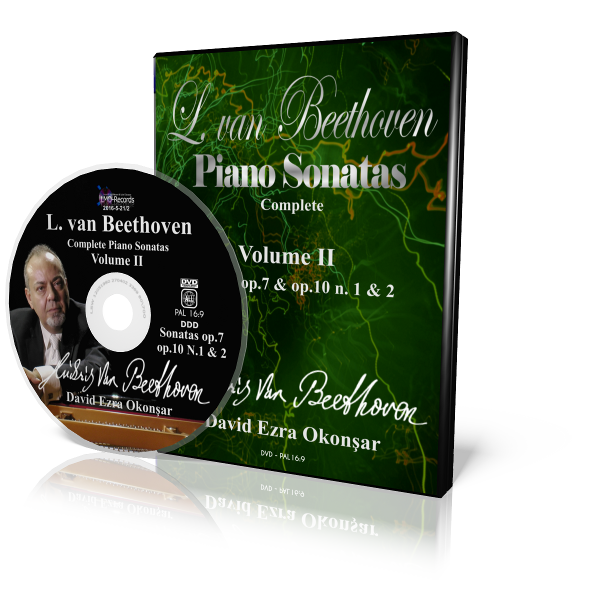
L. van Beethoven
Piano Sonatas VOL. 2
op. 7, op. 10 N.1 & 2
Volume 2 of the series:
The Complete Piano Sonatas by Ludwig van Beethoven



|
Piano Sonata N.4 Opus 7 in E-flat Major Composed in 1796 and published the next year by Artaria in Vienna, the Sonata N.4 in E-flat major opus 7, dedicated to the "Comtesse Babette de Keglevics", was named "Grande Sonate" by Beethoven himself. This is a clue, together with its single opus number and it being published alone, on how high it was esteemed by the composer. It is the second longest Sonata, after the Hammerklavier Opus 106, and lasts for more than half an hour. With this sonata, the entire piano style of Beethoven enters into what may be called the "Symphonic Piano". It is where the keyboard gets its new identity, abandons "old" idioms and starts to simulate an entire orchestra. The first movement, Molto allegro e con brio, starts with a packed energy from the animated left hand, repeating the tonic note supporting the right hand's tonic chords. The "sound-color" of the key of E-flat major is omnipresent. The beginning chords almost state that the E-flat major tonic chord is the "theme" of the movement. It is also associated with the E-flat major arpeggio theme which will not only constitute the theme of the third movement, but also the main idea of the "Eroica" (third) symphony. This E-flat major arpeggio idea is presented here as compact tonic chords. The movement fearlessly explores new territories in the keyboard techniques and ideas like leaps, runs of "legato" octaves, foreign modulations. Largo con gran espressione is one of the most beautiful second movements of all 32 sonatas. In the key of C major, this "Largo" "with big (large, impressive) emotion" brings out the expression of a deep meditation in music. The theme, cut into short fragments with probably the most expressive rests ever composed, leads to a hymn-like development. Large chords to be played legato over a "sempre staccato" bass line. The third movement, Allegro, is not actually a Scherzo neither a Menuet but something in between. It is extremely gracious and evaporative, it sounds more like a "relief", as if getting back to life after the deep interrogations of the preceding slow movement. The rests in this movement's serpentine theme also reminds us the ones in the Largo. Its Trio, indicated "Minore" by the composer, in E-flat minor, carries a dark and subterranean agitation. With both hands playing triplets at a required (very high) speed, emerges, with the use of the pedal, an obsessive melody which contrasts boldly with the gracious theme of the movement. A superb last movement, indicated "very, slightly allegro (Allegretto) and with grace": Rondo, poco allegretto e grazioso, presents one of the most delicate and refined Rondo themes ever. The accompanying lines are fully orchestral in their designs. After a strong and virtuoso section in C minor and immediately before a very peculiar Coda, emerges an interesting prolongation in E major introduced by a chromatic modulation. Beethoven makes full use of the sound-color of the prevailing key of E-flat as opposed to E major. The "Grande Sonate" opus 7 has the most evaporative and refined Codas ever. As if this, more than half an hour-long story, now dissolves and disappears without a trace.Sonata N.1 in F minor op.2 n.1 This first "Grande Sonate" belongs to the series opus 2 with the two following ones and are dedicated to the "Docteur en Musique Joseph Haydn". Composed between 1794 and 1795 they were first published by Artaria in Vienna with the mention "Sonatas for pianoforte or Harpsichord". They were first performed by the composer, before Haydn, in a private concert at the Prince Lichnowsky's court. Audience acclaimed the new compositions, except for Haydn, who, presumably, liked them but recommended his pupil (Beethoven) to keep learning. But we well know, from many other sources the complex relationship between one illustrious and very distinguished yet somewhat distant teacher and his greatly talented pupil. This first Sonata still has a Menuet as a third movement, very typical with its major key Trio and a rather conventional second (slow) movement in the manner of a Haydn or Mozart, deployed as a theme and ornamental variations. This second movement "Adagio" seems to be written as a development of a quartet in C Major from 1785. The first theme in the dark and tormented key of F minor is deployed as an arpeggio in the first movement, Allegro. The F minor arpeggio as a theme will, interestingly, re-appear in the famous "Appassionata". Both themes do have a strange similarity. The following movement Adagio presents a serene theme in F major, masterly varied in its diverse expositions, similar to the best slow movements of Haydn and Mozart sonatas. The elegant Menuetto is, following the tradition, crafted with a typical strings-trio type of ecriture. One of the many places in Beethoven's piano works, where the pianist must have a perfect legato touch and create the illusion of an ensemble of strings players. The last movement, uncommonly indicated Prestissimo and half-time simultaneously, expands the possibilities and sound limits of the instrument and the average performing limits of the pianists of the time (or of all times?) to new levels. Mozart never employed the indication Prestissimo in a last movement. This, combined with the half-time time signature, the block chords and the extremely contrasting dynamics working as a theme already present us with a new language in music. Piano Sonata N.5 Opus 10 N.1 in C Minor The first number of the next series, the Sonata N.5 in C minor, op.10 n.1 was composed between 1796 and 1798. After the two "easy sonatas" (opus 49 number 1 and 2), which are actually "sonatines" written for the use of the composer's pupils. Also from the same period is a "Sonate pour clavecin ou piano solo a quatre mains" in D major, also a didactic piece without much interest in it. However, this C minor sonata is a masterpiece. All three Sonatas of opus 10 were dedicated to the Comtesse Anna Margarete von Braun (or "Browne") and all published in Vienna in 1798 by the firm Eder. Interestingly, the composer wrote: "in my new Sonatas [are] very short Menuets, not longer than sixteen or twenty-four bars long...". Yet, the first two, opus 10 N.1 and N.2, are with three movements, only number 3 has a Menuet. One of the most remarkable aspects of this new series, opus 10 is best described by Paul Badura-Skoda: "The three Sonatas reveal a more subtle formulation of the score, specially in the inner voicing textures. And more importantly, an even more "organic" connection between parts and movements. This will be sustained and improved upon by the composer all his life. As with each new series, we have here an evolution characteristic of the artist." Movements are all brief and powerfully compact. The analogy between the theme of the first movement: Molto allegro e con brio and the one in Mozart's C minor sonata K 457 is widely known and discussed. However, in Beethoven, we have this unique dialogue between voices and fragments, where phrases oppose to one another, conflict and start again in different directions. The very idea of a Beethoven Sonata, which is the duality of two contrasting ideas confronted to each other, the composer called that "two principles", is fully present here and will be the basic underlying notion in most sonatas to come. The culmination of it will be the two movement scheme of the last Sonata, opus 111. The development section of the opus 10 n.1 starts in C major, but this will be used as a dominant to introduce the beautiful melody in F minor played with legato octaves. The movement in A-flat major, Adagio molto, is in a sort of sonata-form without a development. A serene theme, using a most melodious grupetto figure is often briskly cut with arpeggiated chords and "fusées" i.e. very fast arpeggios (or scales) notated with smaller note-heads. The Finale: prestissimo is again in a sonata-form with two clearly defined themes. Fast and brilliant it ends, however, pianissimo on a very low section of the keyboard. Piano Sonata N.6 Opus 10 N.2 in F Major Paul Badura Skoda underlines the analogy between the next one: Sonata N.6 in F major op.10 n.2 and the F major sonata Hob.XVI/23 by Joseph Haydn. Specially regarding the rhythmical structures of the first and last movements. Is this a "getting back" to the style of the first series, opus 2 and to the style of his teacher: Haydn? Even though a "Haydn-esque" general feeling may be seen throughout that sonata, the language of Beethoven evolved so much since opus 2 that getting back is impossible. Furthermore, in none of his sonatas Beethoven looks back nor repeats himself. However, a fine and incisive sense of the "surprise" idea is a characteristic of this work. Right from the first movement Allegro, one sharp and incisive theme in F major: two short (staccato) chords and their "complement": the joyous motive in triplets gives the overall "tone" and feeling. The time shifting in the typical Alberti bass figure accompanying the second lyrical theme worth noting. By starting off the beat, the conventional figure of accompaniment used over and over by preceding composers creates here a totally new sound with the bass notes being displaced. A "false" re-exposition in the key of D major surprises us, but very shortly it turns to D minor and brings the "real" re-exposition in F major. It seems that Beethoven had a great deal of fun composing this movement. The second movement: Allegretto in F minor starts on a low range with both hands playing in unison. As always with the key of F minor, the theme is an arpeggio figure. The notes C-F-A-flat in no other key, but in F minor seem to be one of the typical "key-sounds" of the composer. They are seen in the first movement of the first sonata in F minor, opus 2 N.1 and the "Appassionata". The rhythmically simple but very effective procedure of having both hands play on syncopes, displaced by half a beat, is also used here to great effect. A fast, joyous and staccato, "quasi" fugue style is all over the Finale: presto. Yet a "fugue" with lots of parallel octaves and with the most audacious modulations. |
|||||||||||||||||||
| |
|||||||||||||||||||
|
|
|||||||||||||||||||
|



